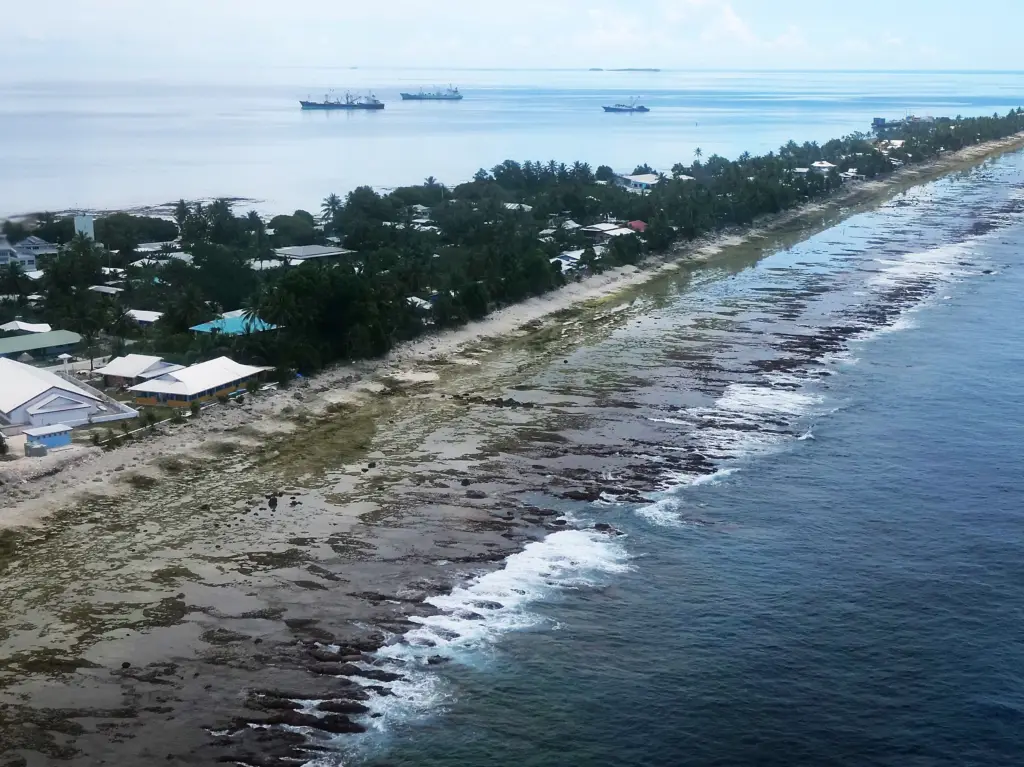Several countries, and more specifically, some cities are in danger from rising sea levels due to climate change. Countries like the Maldives, Vanuatu, The Solomon Islands and Kiribati are at risk of being under water by 2050. Some cities like Miami, NYC, Tokyo, Shanghai, Venice, Bangkok, and Lagos are also at risk of going underwater.
Since the beginning of the industrial era in the 18th century, the world has experienced an increase in average temperatures which has resulted in climate change. The United Nations reports that global temperatures have increased by 0.85℃ since the industrial era began. This has led to several impacts including the rising of sea levels due to the melting of ice in the Arctic region.
Sea level rise is one of the most catastrophic impacts that can destroy homes, farmlands, and properties. These affected territories can become uninhabitable countries in the near future due to climate change.
In 1992, the UN recognised 58 countries that face social, economic and vulnerable challenges called the Small Island Developing States (SIDS). Most of these countries which are made up of Caribbean countries and Pacific islands are mostly tourist attraction sites due to their beautiful beaches. However, they currently face some of the most devastating impacts of climate change.
Sea level rise, coastal erosion, salinization, and a host of other impacts are now threatening some of these small countries that have seen some of their cities disappear underwater. This could render these countries uninhabitable, possibly leading to mass migration.
As an environmental scholar and lecturer myself, I have first-hand information from various research that the sea level rise that has been happening in the past few years will only continue if we do not take appropriate action.
In other to create awareness and bring this to light, we have decided to compile a list of countries, and specifically some cities that would most likely be under water in the coming future. Hopefully, your city isn’t on the list. But I bet you have friends that live in these cities.
I personally have family living in Lagos Nigeria. There is a year flooding menace in Lagos every year, and each year it gets worse.
I hope that by the time you are done reading this article, you will find creative ways to help and be a part of the solution to climate change, as opposed to being a contributor. Read on
10 countries that may be uninhabitable by 2050
1. The Maldives

Officially called The Republic of Maldives, this country is located in South Asia along the Indian Ocean. This small country lies southwest of Sri Lanka and consists of 20 atolls making it an archipelago.
With a total land area of 300km, The Maldives is home to 579,000 people. The country has a tropical monsoon climate with two dominant seasons which are the dry and rainy seasons.
In 2007, the Intergovernmental Panel on Climate Change’s report predicted that the sea level would rise by 23 inches by 2100. Researchers from Southampton University also name the Maldives the most endangered island nation as a result of its vulnerability to flooding caused by climate change.
This beautiful Island country may be gone in a few years so make hay while the sun shines and make that visit happen before the Maldives goes under water.
See also: Is Climate Change a Hoax?
2. Kiribati
One of the countries most susceptible to climate change is Kiribati. Kiribati is an exceptionally remote and low-lying island country that is very vulnerable to climate change and sea level rise. Kiribati had an estimated population of 113,000 in 2020, of which over half lived on the island of South Tarawa, where the capital Tarawa is located.
The entire population and most infrastructure are concentrated along the coast making it directly exposed to the impacts of climate change. The country faces the threat of persistent flooding as well as the deterioration of land and marine ecosystems due to the current rate at which the sea levels rise.
3. Vanuatu
Vanuatu is a remote archipelago country that is home to about 260,000 residents. The country consists of 82 volcanic islands that spread across 800 miles.
Vanuatu is one of the countries that could cease to exist in the near future due to the impacts of climate change. By 2030, temperatures are expected to rise by up to 1 degree which can cause the sea levels to rise.
In addition, Vanuatu is also expected to experience more severe cyclones and ocean acidification that make the food sources vulnerable to pests and diseases. If you are planning to see this country in your lifetime, now is the time to plan that trip before it actually becomes one of the uninhabitable countries.
4. Solomon Island

This South Pacific island is an archipelago containing about 1000 islands. Within the past century, 6 islands had already disappeared with an additional 6 islands already submerged in seawater by an average of 41%.
This is proof that if nothing is done to mitigate the effects of climate change on this small Island country, it may cease to exist in the near future.
5. Tuvalu
Tuvalu is a small island situated in the Pacific between Hawaii and Australia. The country is made up of nine small islands with the majority of these islands being coral atolls.
Due to climate change, there has been a recorded rise in sea levels as high tides are becoming more dangerous. This could mean that this Island country may be completely buried in seawater in a few years’ time making it one of the uninhabitable countries if strict measures are not taken to limit these impacts.
6. Samoa
This country has experienced an increase of 1.5 degrees in average annual temperature as a result of climate change that is projected to cause increased precipitation and hotter temperatures.
Samoa faces the risk of sea level rise and saltwater intrusion that can have major impacts on their agriculture and as well, threaten the existence of the country.
In 2021 Samoa government with the support of the UN Environment programme began a National Adaptation Plan to help improve climate adaptation efforts.
7. Fiji Island

This country is vulnerable to rising sea levels, extreme weather and coastal erosion. The economy of Fiji may likely be affected by these changes, which can also result in a temperature rise.
Tourism, agriculture, and fisheries, which make up the majority of the country’s GDP, would be adversely damaged by climate change, leading to rises in poverty and food insecurity.
8. Nauru
According to studies, there is a very high chance that as a result of climate change, the water stress on Pacific islands would increase. This is expected to feature problems in Nauru brought on by heavy rainfall events.
While this sounds good for Nauru due to their lack of water sources except for the rain and the sea, it could pose a threat to this small island by causing more coastal erosions, higher tides and sea level rise which can threaten the existence of this small country.
9. Marshall Island
High tides and frequent storms have caused sea level rise that is threatening inhabitants of this Pacific Ocean atolls. Research indicates that this island has experienced a 3.4-millimetre increase in sea levels annually which could lead to an 80% loss if the sea level rises by a metre.
At this rate, it is not hard to imagine that this country may go underwater in a few years if stringent measures are not taken to prevent this.
10. Grenada

Grenada is located between the Atlantic and the Caribbean oceans. This island country has a total land area of 345 square km with an estimated population of 113,000 people in 2020. The highest point of Grenada is 840m (Mount Saint Catharine) however, about 3% of its land is at sea level.
Grenada has experienced increased forest fires, water shortages and crop loss in recent years due to climate change. Consequently, these effects could force inhabitants to look for other habitable areas as this territory could be declared an uninhabitable country soon.
List of Cities That Will be Underwater Due to Climate Change
Cities like Miami and New Orleans in the United States, cities with canals like Amsterdam and Venice, and other significant destinations like Kolkata and Dhaka might all be submerged underwater within the next few decades.
The cities are an urgent reminder that inaction today will have lasting effects on future generations. We’ve talked about several countries that are very likely to be underwater by 2050. Now let’s talk specifically about some big and important cities that would most likely be underwater by 2050.
Below are some cities that will be underwater due to climate change:
1. Amsterdam, Netherlands

The city of Amsterdam, along with roughly two-thirds of the Netherlands, is at risk of flooding. The cities of Amsterdam, Rotterdam, and The Hague are all situated on low, flat terrain in close proximity to the North Sea.
Amsterdam was in serious danger long before the fear of rising sea levels became a reality. It features a waterfront location with numerous canals.
Fortunately, the Dutch are widely regarded as the world’s foremost authorities in flood control, and many of the strategies they are enforcing in Amsterdam are being adopted in New York City, which is also known as New Amsterdam.
The Dutch are well-known for their flood defences, and these predicted increases in sea level show that they will become even more necessary in the future.
2. Venice, Italy

With the rising global sea level, Venice is one of the cities that will be underwater due to climate change. St. Mark’s Square, the Basilica of St. Mark, and the Crypt are all prominent tourist attractions in the city, but they have all been severely flooded.
High water tides (known as Acqua Alta) have become more common as a result of climate change, which has also brought about other odd weather patterns. For as long as anybody can remember, Venice has had to contend with flooding, therefore the city has set up more than one flood defense system.
However, these will become increasingly challenging and expensive to maintain as the situation continues to spiral downward.
3. New Orleans, USA

New Orleans serves as a major port for both domestic and international trade. The port of New Orleans is vital to the city’s economy, but it is currently in danger from a series of severe storms.
New Orleans is still in danger even after the destruction caused by Hurricane Katrina, which flooded 80 percent of the city. Since this city is at the meeting point of a lake, a river, and the Gulf of Mexico, and since much of it is below sea level, it’s not surprising that flooding is going to get worse in the future.
4. Kolkata, India

Kolkata is only 5 feet above sea level and is surrounded by a number of rivers. The large wetland area located close to the city is a potential lifesaver in the case of a flood.
Much of this wetland is currently being developed and may be lost. The city once had over six hundred marsh areas, but as of 2016, just twenty-seven remained.
If the city does not take advantage of the natural benefit of well-preserved wetlands, it is likely to become of the cities that will be underwater due to climate change. This could have a disproportionately negative impact on the city’s poorer citizens.
5. Mumbai, India

The economic capital of India is one of the cities that will be underwater due to climate change as we enter the next century. The city is already vulnerable to flooding due to the heavy rains and cyclones that have hit the area.
Every year during the monsoon, the highly populated city of Mumbai is at risk of flooding, tree uprooting, water entering homes, and even house collapse due to the heavy rainfall.
Scientists project that by 2050, much of it will be underwater because it was built on islands that may soon disappear.
6. Jarkata, Indonesia

Simply put, no city is sinking faster than Jakarta in Indonesia. orth Jakarta has sunk 2.5 meters in the last 10 years and is continuing to sink by roughly 25 centimeters per year; by the end of 2050, it is predicted that up to 95% of North Jakarta would be underwater.
This pace of sinking is twice as fast as the norm for coastal megacities around the world. Because of how bad the situation is, the government has chosen to move 10 million people 100 miles elsewhere. This will take around 10 years and cost roughly US$33 billion.
7. Lagos, Nigeria

More than 24 million people call Lagos home, making it Africa’s most populous metropolis. Nigeria’s largest city, Lagos, is another city that will be underwater due to climate change, which causes coastal erosion and rising sea levels.
As a result of climate change, it is also the most susceptible to rising sea levels. The ineffectiveness of Lagos’s waste management system means that the city’s streets will become increasingly clogged with trash as the frequency and severity of heavy downpours grow.
When it rains a lot, trash fills up the open gutters and makes it hard to navigate around town.
8. Miami, Florida

Rising sea levels are having a negative impact on Miami, causing flooding, tainted drinking water, and extensive damage to houses, roads, and infrastructure. To prevent flooding, the city may need to elevate its buildings shortly.
In 2017, severe damage was done to the city by Hurricane Irma, illustrating the danger posed by such storms. Some estimates project a 6-inch rise by 2030 and a 2-foot rise by 2060 in sea level.
Approximately a third of the existing population of Miami-Dade County would have to relocate as it is one of the cities that will be underwater due to climate change.
9. Dhaka, Bangladesh

The New York Times reports that although Bangladesh is only responsible for 0.3% of global warming emissions, and very likely to to bear the brunt of the damage caused by rising sea levels.
Already experiencing severe flooding, it is predicted that by the year 2050, almost 17 percent of Bangladesh will be underwater, forcing 20 million people to relocate. Dhaka, the country’s largest metropolis and the nation’s capital, is at risk from the increasing frequency of yearly coastal floods.
10. Basra, Iraq

The city of Basra, Iraq, is the country’s primary port and is located on the Shatt al-Arab, a massive river that empties into the Persian Gulf.
As a result of the city’s many waterways and the surrounding marshland, Basra and its environs are particularly at risk from rising sea levels. In addition, Basra has a serious problem with water-related infections, thus the additional flooding poses even greater dangers.
Conclusion
It is sad to see how many lives and homes are being threatened in many SIDS countries and cities around the world due to climate Change. Some of these vulnerable states have called for adaptation and mitigation efforts with support from organisations such as the UN, CARICOM, PIF and a host of others.
Indeed, mitigation efforts are being made with the hope that these efforts may have a positive impact on not only the countries but the planet at large.
Despite best efforts to adapt to the changes brought on by climate change and lessen the impact of the phenomenon, some cities may one day find themselves underwater.
For the sake of the millions of people who live in these cities, governments, legislators, and communities must make efforts to mitigate and adapt to the effects of climate change a top priority.
Related posts:
- Harnessing the Power of the Sun: A Guide to Solar Installation - February 12, 2024
- Vacuum Trucks: The Unseen Heroes of Waste Management and Their Environmental Benefits, Featuring McDonald Farms - December 11, 2023
- Satellites And Climate Adaptation: Solutions From Space - December 1, 2023







Yea okay. Just like how the climate cult screamed and cried when the year 2000 came. The year 2000 came and went….Every prediction and narrative they’ve put out has fallen flat on its face. The earths climate has NEVER STAYED THE SAME!!! It’s always changing!!! It’s not bc of humans that the climate changes!! When a giant tornado or hurricane hits the climate tards go nuts!!! They say that this hurricane is bc of climate change, look how enormous it was!!! But then any rational human being with a functioning brain and reasoning skills can easily look back in history and find 100 years ago there was a storm of the same magnitude or bigger!!!! In 5 yrs nothing will happen. In 50yrs nothing will happen. The bar just keeps being pushed back
Human ingenuity has always been on top of things since time immemorial. But to achieve these feats, there was never a time we folded our hands and hoped on nature to fix stuff. We still have to do our best and prepare for the worst.
Climate change is a natural process. The earth has always changed, but the fact remains that we are mostly responsible for this current change and therefore, we do have to do our best to make sure that the planet is changing on its own, rather than changing as a result of our own activities.
Personally, I think there are some climate change alarmists here and there, but all in all, the climate is actually changing.
Eventually something will happen if the axis angle continues to increase and it will !!! Seems information about water levels rising is available, where is information concerning hours of light n dark, areas that will become cold and freeze? Government again hiding information and lying without putting forth all information? Government should be preparing to move people in advance of areas perceived to flood to get out ahead of crisis would be much better way to deal with an issue that is natural and can not be stopped
It’s already happening.
Sorry to say, but you are simoly stupid.
The Earth has gone through cycles of excess heat followed by cold. Animal life’s been adapting to climate for millions of years and will continue I suspect. we won’t be here our descendants will mutate to adjust.
This is true to a very large extent, but there are a lot of uncertainties. You are assuming that we would adapt and not die off. A lot of species have gone into extinction because they just couldn’t adapt to the changing ecosystem. So we are safer trying to reduce the effects of climate change than hoping that our species would adapt. Do you get where I am driving towards?
climate alarmists? if you aren’t alarmed by now you aren’t paying close enough attention…
Good point
The increasing angle of the earths axis is causing some areas to heat, others to cool. Some areas will experience various light and dark like Alaska. Smart people will move, man will not become extent just will not live where man currently lives. Man will need to migrate with the easterly increasing axis angle. Antarctica and Alaska will eventually flip, Antarctica will be North opposed to South. Last time Antarctica was in the North was 780Million years ago.
Sea level rise is only one of the effects of climate change.
We also need to consider temperature extremes. Many regions near the equator will soon have high temperature days where human beings cannot survive, even in shade.
What is happening isn’t climate change that is claimed to be caused by man using fossil fuels, that isn’t true ! Climate has always been changing since dawn of time. It’s the earths axis is constantly changing, currently axis angle increases by 1.7” per year. Earths changing axis has destroyed civilizations and caused animals to go extinct NOT fossil fuels. Man can not reverse the earth axis increasing! Nothing man can do to help with tilt angle. The equator will and is moving, so are the N and S Poles. Some countries will go dark and others will remain in the light for extended periods of time will be normal. The N and S Poles are going to flip, Alaska will be in the South, where Antarctica is. Last time Alaska and Antarctica flipped was 780 million years ago. Man can do nothing to prevent this from happening. Time to use the fossil fuels they are better than wind turbines polluting the Coastlines. Solar is good in small applications like houses and help the utility companies one house at a time
HI OUT THERE,, WELL AM 82 YEARS OF AGE,, BORN IN CANADA, 1941,, WELL AS I SEE IT, WOW AM I EVER GLAD THAT AM FROM THE GOOD PAST,, REASON I SAY THIS WE THE PEOPLE OF THE PAST ,SHARED,, SUPPORTED EACH OTHER, AND WORKED TOGETHER, TO LIVE A GOOD LIFE,, WHEN I SAY THIS ,, THEN CAMICALS WAS NOT KNOWN, ,,NOW THE FOOD WAS PURE,, THE AIR WAS PURE,, AND WE WEIR A HEALTHY UNEDUCATED AND BELIEVERS IN WHAT WAS AROUND US,, YES WE HAD A GOOD LIFE,, BUT NOW I LOOK AROUND, AND SEE THAT ITS NOT THE SAME IN SHEARING,, AND RESPECT. ITS ALL FOR ONE, ,,AND YOU HEAR FROM THE YOUNG ,, GET WITH IN YOU OLD FARTS, WOW, YES I WANT A FEW MORE GOOD YEARS,, WITH THE PEOPLE OF YESTERDAY,, THANK YOU ALL AND DO TAKE CARE, GARY LAJOIE, OH I HAVE BEEN IN THAILAND 22YEARS, ENJOYING A GOOD LIFE,